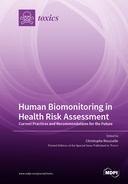Explore

Human Biomonitoring in Health Risk Assessment
0 Ungluers have
Faved this Work
Login to Fave
Europe’s zero-pollution agenda should depart from an understanding of how the European citizens’ bodies are polluted by synthetic chemicals and prioritize the reduction of the chemical body burden and associated health impacts. In this context, Human Biomonitoring (HBM) is an important and valuable tool for assessing the internal exposure of humans resulting from aggregated exposure to chemicals. Though many obstacles still hinder the use of HBM data, the growing availability of HBM data offers an opportunity for improving and refining Human Risk Assessment. This Special Issue intends to illustrate, using case studies, how HBM data could be used to better estimate internal exposure and resulting risks. Case studies on exposure from consumer products (cosmetic products, non-food products, etc.) or exposures via food or water in the general population or among workers contributed to better identifying the obstacles hindering a broader use of HBM data in RA. A better understanding of population exposure and the exposure of vulnerable groups against health-based human biomonitoring guidance values also provides the basis for effective risk management to reduce impacts on health. I would like to thank all the authors for submitting their original contributions to this Special Issue. We greatly appreciate the support of all the reviewers who spent time evaluating and improving the quality of the manuscripts. I would also like to thank the editors of Toxics for their kind invitation and Selena Li of the Toxics Editorial Office for her invaluable support.
This book is included in DOAB.
Why read this book? Have your say.
You must be logged in to comment.
Rights Information
Are you the author or publisher of this work? If so, you can claim it as yours by registering as an Unglue.it rights holder.Downloads
This work has been downloaded 104 times via unglue.it ebook links.
- 104 - pdf (CC BY) at Unglue.it.
Keywords
- Adipose Tissue
- Benzene
- benzophenone-3
- biological monitoring
- biomarker
- biomarkers
- biomonitoring
- bisphenol A (BPA)
- bisphenol S (BPS)
- bisphenols
- bystanders
- carcinogenicity
- Children
- Chlorpyrifos
- co-exposure
- COVID-19 Pandemic
- dietary exposure
- dimethylformamide
- DMF
- Elements
- Endocrine Disruptors
- European Human Biomonitoring Initiative (HBM4EU)
- exhaled breath condensate
- exposure
- fruits
- general population
- guidance value
- HBM-GV
- HBM4EU
- health effects
- human biomonitoring
- human biomonitoring (HBM)
- human biomonitoring guidance value (HBM-GV)
- Internal exposure
- Liver
- Lockdown
- Lung Diseases
- malondialdehyde
- margin of safety
- MDA
- Medical Toxicology
- medicine
- Mercury
- Meta-analysis
- meta-regression
- metabolomics
- Methylmercury
- mineralogical analysis of broncho-alveolar lavages
- mixture risk assessment (MRA)
- n/a
- Nanoparticles
- occupational exposure
- occupational health
- operators
- organophosphorus flame retardants
- ortho-toluidine
- Other branches of medicine
- Oxidative Stress
- paints production
- partition coefficients
- PBPK modelling
- persistent organic pollutants
- pesticide exposure
- pesticide risk assessment
- Pesticides
- Pharmacology
- physiologically based pharmacokinetic modelling (PBPK)
- RCR
- reference range
- reference values
- reprotoxic effects
- residents
- Risk assessment
- Rome
- systematic review
- systemic exposure
- TiO2 powders
- toxicokinetics
- tree-grown produce
- urban traffic
- urinary biomarker
- urinary mass-balance
- UV filters
- vine
- Workers
- Workplace
Links
DOI: 10.3390/books978-3-0365-7005-1Editions

